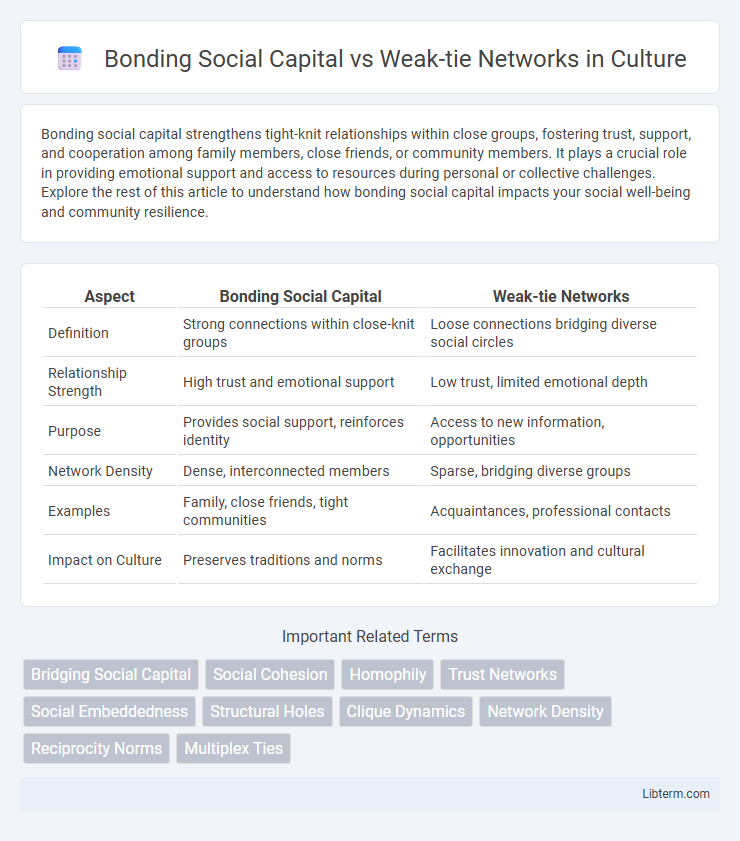Bonding social capital strengthens tight-knit relationships within close groups, fostering trust, support, and cooperation among family members, close friends, or community members. It plays a crucial role in providing emotional support and access to resources during personal or collective challenges. Explore the rest of this article to understand how bonding social capital impacts your social well-being and community resilience.
Table of Comparison
| Aspect | Bonding Social Capital | Weak-tie Networks |
|---|---|---|
| Definition | Strong connections within close-knit groups | Loose connections bridging diverse social circles |
| Relationship Strength | High trust and emotional support | Low trust, limited emotional depth |
| Purpose | Provides social support, reinforces identity | Access to new information, opportunities |
| Network Density | Dense, interconnected members | Sparse, bridging diverse groups |
| Examples | Family, close friends, tight communities | Acquaintances, professional contacts |
| Impact on Culture | Preserves traditions and norms | Facilitates innovation and cultural exchange |
Understanding Bonding Social Capital
Bonding social capital refers to the strong, close-knit connections among individuals within a homogeneous group, fostering trust, mutual support, and shared identity. It strengthens social cohesion by enabling cooperative behavior and emotional support in tightly bonded networks such as families and close friends. In contrast, weak-tie networks involve more casual, diverse connections that facilitate information flow and access to new opportunities beyond immediate circles.
Defining Weak-tie Networks
Weak-tie networks consist of acquaintances or distant connections that provide access to new information and diverse resources beyond immediate social circles. These weak ties play a critical role in bridging structural holes, facilitating innovation, and expanding opportunities in professional and social contexts. Unlike bonding social capital, which strengthens close-knit relationships, weak-tie networks emphasize the value of loose connections in generating social mobility and knowledge diffusion.
Core Differences Between Bonding and Weak-tie Connections
Bonding social capital refers to strong, close-knit relationships typically found within homogeneous groups that provide emotional support and trust, while weak-tie networks consist of more casual, diverse connections that offer access to new information and broader opportunities. Core differences include the depth of trust and emotional intensity, with bonding ties fostering solidarity and weak ties facilitating resource brokerage and innovation. Bonding ties prioritize internal cohesion and mutual aid, whereas weak-tie networks emphasize bridging different social circles and expanding social reach.
The Role of Trust and Reciprocity
Bonding social capital emphasizes strong, close-knit relationships characterized by high levels of trust and mutual reciprocity, often found within families or tight communities. Weak-tie networks, by contrast, connect more distant acquaintances, facilitating access to diverse information but involving lower immediate trust and reciprocity. Trust in bonding social capital fosters collective action and support, whereas reciprocity in weak-tie networks promotes information exchange and bridging social capital across different groups.
Network Density and Information Flow
Bonding social capital is characterized by dense networks where strong ties facilitate trust and support, enhancing cohesive group collaboration but limiting diverse information flow. Weak-tie networks exhibit lower density, allowing for more bridges between disparate groups, which promotes access to novel information and broader opportunities. Network density in bonding social capital often restricts information diversity, while weak-tie structures optimize information diffusion across social boundaries.
Social Support versus Resource Access
Bonding social capital fosters strong, close-knit relationships that provide emotional support, trust, and mutual aid essential for personal well-being and coping with stress. Weak-tie networks, characterized by more distant and diverse connections, excel in offering access to novel information and resources, facilitating opportunities such as job leads or innovation. While bonding capital strengthens social support within homogeneous groups, weak ties enhance resource access across different social circles and wider communities.
Community Strength: Cohesion or Reach?
Bonding social capital fosters strong community cohesion by encouraging close-knit relationships and mutual support within homogeneous groups, enhancing trust and collective identity. Weak-tie networks, however, expand community reach by bridging diverse social circles, facilitating access to novel information and resources beyond immediate groups. Balancing bonding social capital and weak-tie networks is crucial for a community's overall strength, combining deep internal cohesion with broad external connections.
Impacts on Individual Opportunity
Bonding social capital, characterized by strong, close-knit relationships, enhances individual opportunity by providing emotional support, trust, and access to reliable resources within homogeneous groups. Weak-tie networks connect diverse social circles, expanding access to novel information, job leads, and unique opportunities that are not available in tightly bonded groups. Individuals leveraging weak-tie networks often experience greater occupational mobility and innovation due to broader exposure beyond immediate social clusters.
Challenges and Limitations of Each Network Type
Bonding social capital, characterized by strong, close-knit relationships, often faces challenges such as insularity and resistance to new ideas, limiting access to diverse resources and opportunities. Weak-tie networks, while beneficial for spreading information across broader social circles, may suffer from lack of trust and emotional support, reducing the strength and reliability of connections. Both network types encounter limitations in balancing depth of interaction and breadth of reach, which can impact individual and community resilience.
Integrating Bonding and Weak-tie Strategies for Success
Integrating bonding social capital and weak-tie networks enhances access to diverse resources while maintaining strong relational trust, fostering both support and innovation. Bonding social capital strengthens close-knit groups through deep trust and shared norms, whereas weak-tie networks connect individuals across different social circles, facilitating information flow and new opportunities. A strategic balance between these elements drives collaboration, resilience, and competitive advantage in organizational and community settings.
Bonding Social Capital Infographic

 libterm.com
libterm.com